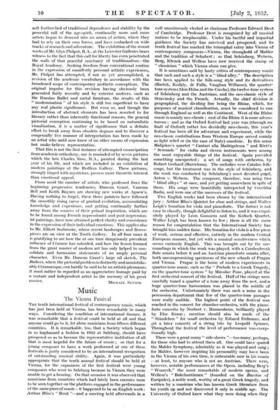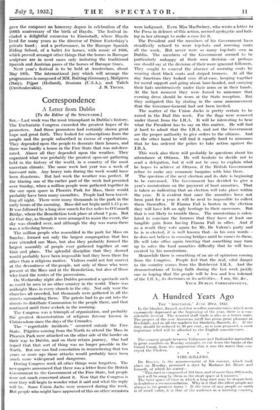Music
The Vienna Festival
THE tenth international festival of contemporary music, which has just been held at Vienna, has been remarkable in many ways. Considering the condition of international finance, it was remarkable that a festival could be held at all and that anyone could go to it, let alone musicians from fifteen different countries. It is remarkable, too, that a Society which began in so haphazard a fashion in 1922 at Salzburg, should have prospered so as to become the representative institution of all that is most hopeful for the future of music ; so that for a young composer to have a work performed at one of these festivals is justly considered to be an international recognition of outstanding musical ability. Again, it was particularly appropriate that the tenth annual festival should be held at Vienna, for the organizers of the first festival were young composers who went to Salzburg because in Vienna they were unable to get a hearing. On that occasion it was observed that musicians from countries which had lately been enemies were to be seen together on the platform engaged in the performance of the same piece of music—it happened to be an English work : Arthur Bliss's "Rout "—and a meeting held afterwards in a café unanimously elected as chairman Professor Edward Dent of Cambridge. Professor Dent is recognized by all musical nations to be irreplaceable. Under his tactful and impartial guidance the Society has survived and prospered, and its tenth festival has marked the triumphal entry into Vienna of contemporary composers—Vienna, the stronghold of Mahler and the tradition of Schubert ; so that Schonberg, Webem, Berg, Ktenek and Wellesz have now received the stamp of " classicism " which Vienna alone can give.
It is sometimes said by hasty critics of contemporary music that such and such a style is a " blind alley." The description has been applied to the folk-song style and its derivatives (Bartok, Kodfdy, de Falls, Vaughan Williams), the quarter tone system (Alois Halm and the Czechs), the twelve-tone system of Schonberg and the Austrians, and the neo-classic style of Stravinsky and the French. Actually, the chief division is geographical, the dividing line being the Rhine, which, for purposes of musical classification, must be considered to run through England as well as the Continent. West of the Rhine music is mainly neo-classic ; east of the Rhine it is more adven- turous; and as the Oxford festival last year was (through no fault of Oxford) rather too decidedly neo-classic, this year's festival has been all for adventure and experiment, while the neo-classic contributions from Western Europe served mainly as light relief or (in the case of Italy) sunshine. In this sense Malipiero's quartet " Cantari alla Madrigalesca " and Rieti's
Serenade" for violin and eleven instruments were among the most enjoyable things of the festival. Spain provided something unexpected ; a set of songs with orchestra, by Robert Gerhard (Barcelona). The melodies were Catalan folk- songs, but the treatment was in the style of Schonberg, and the work was conducted by Schonberg's most devoted pupil, Anton v. Webern. The composer, therefore, was using two "blind alleys" at once, and yet getting somewhere in spite of them. His songs were beautifully interpreted by Conchita- Badia, and were one of the successes of the festival.
Two English works had been chosen by the international jury : Arthur Bliss's Quintet for oboe and strings, and Walter Leigh's Sonatina for viola and pianoforte. The former is not easy to classify, though delightful to listen to, and it was exqui- sitely played by Leon Goossens and the Kolisch Quartet. Walter Leigh has been known to few ; there is all the more reason for congratulation that the International Society has brought him sudden fame. His Sonatina for viola is a fine piece of work, serious and effective, entirely in the modem Central European manner, but yet with a musical sensitiveness which seems curiously English. This was brought out by the sur- roundings in which the work was played, with a Czechoslovak flute sonata before it and an Austrian pianoforte sonata after, both uncompromising specimens of the new schools of Prague and Vienna. Prague is the home of modern experiments in quarter-tone music, such as the "Prelude to a Greek Tragedy, on the quarter-tone system" by Miroslav Pone, played at the first orchestral concert of the festival. Half of the strings were carefully tuned a quarter of a tone away from the rest, and a huge quarter-tone harmonium was placed in the middle of the orchestra. Unfortunately there was such a noise in the percussion department that few of the quarter-tone passages were really audible. The highest point of the festival was reached in the concert for chamber-orchestra, with the piano- forte concerto by Norbert v. Hannenheirn, brilliantly played by Else Kraus ; mention should also be made of the " Standchen " for small orchestra by Eduard Erdmann, and (at a later concert) of a string trio by Leopold Spinner. Throughout the festival the level of performance was excep- tionally high.
There were a great many" side-shows "—too many, perhaps, for those who had to attend them all. One could have spared the Mahler Symphony, admirably as it was played and sung ; for Mahler, however inspiring his personality may have been in the Vienna of his own time, is unbearable now in his music —at least, to anyone who is not an Austrian. There were, however, notable performances at the Opera, including Berg's " Wozzeck," the most remarkable of modern operas, and Wellesz's " Bakchantirmen " (founded on the Bacchae of Euripides), a noble work, worthy of a great Greek tragedy, and written by a musician who has known Greek literature from his youth up and not discovered it only in middle age. The University of Oxford knew what they were doing when they gave the composer an honorary degree in celebration of the 200th anniversary of the birth of Haydn. The festival in- cluded a delightful excursion to Eisenstadt, where Haydn lived for many years as the director of Prince Eszterhazy's private band ; and a performance, in the Baroque Spanish Riding School, of a ballet for horses, with music of 1660, which proved amongst other things that the horses in Baroque sculpture are in most cases only imitating the traditional Spanish and Austrian paces of the horses of Baroque times.
Next year's festival is to be held at Amsterdam, about May 18th. The international jury which will arrange the programmes is composed of MM. Butting (Germany), Malipiero (Italy), Pijper (Holland), Sessions (U.S.A.), and Talich







































 Previous page
Previous page